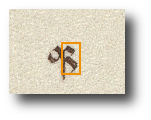Exercise 19

1. Cupientes igitur ut Ecclesia parochialis
2. gloriose virginis Marie in Civitate Cracoviensi congruis honoribus frequentetur et salus proveniat animarum Omnibus cristifide
3. libus contritis duntaxat et confessis qui Altaria eiusdem Ecclesie Sancte Marie ad honorem prefate virginis Marie et sanctorum
4. Sanctarum que dei ibidem erecta et constructa ex devocione visitaverint et oracionem dominicam cum Salutacione angelica ante Altare
5. devote dixerint quandocunque et quocienscunque spiritu divino instincti id fecerint Vel manus de bonis sibi a deo collatis ad ipsius
6. Ecclesie sustentacionem et fabricam adiutrices porrexerint tociens a quolibet Altari sic ut premittitur visitato de omnipotentis dei miseri
7. cordia et beatorum petri et Pauli Apostolorum eius Auctoritate confisi Quadraginta dies indulgenciarum perpetuis temporibus
8. duraturas impartimur et de iniunctis eis penitenciis misericorditer in domino tenore presencium relaxamus
Principles of transcription
┬Ā
- Maintain the original entry - carry out the transcription as faithfully as possible to the original, without correcting the writer's mistakes.
┬Ā - Lines of text - the transcription should be written in lines (fragments in grey should be omitted). If the word is divided between two lines, it should be written as in the original, that is, without connecting it.
┬Ā - Punctuation - all punctuation marks or others (e.g. commas, full stops, hyphens, etc.) appearing in the original should be ignored.
┬Ā - Writing capital letters - the mechanism recognises both small and capital letters as correct.
┬Ā - Contractions - a contraction used by the writer should be written in full. Do not use square brackets to designate additional letters, complementing the contraction.
┬Ā - The letters u and v - in Latin texts they are often exchanged or written in an identical way. While transcribing, the actual, phonetic sound of the word should be used.
┬Ā - The combination of letters qu - we always write as qu.
┬Ā
┬Ā
You can find the full principles of transcription here.
Helpful tips
- In this document there are many contractions, knowledge of them is essential for transcribing the text. Remember that if you click Used contractions there is a set of contractions at your disposal. For general information on the subject of shortening words, click here.
┬Ā - The scribe wrote some letters in two versions. This concerns the letters s, i (not always designated with a dot) and C.
┬Ā - Be careful with the letters u and v - the way of writing them is identical.
┬Ā - The scribe wrote the letter A in an unusual way.
┬Ā
┬Ā
You will find more useful tips for transcribing old texts here.
Exercise 19
Model letters


































Exercise 19
Abbreviations
![animaru[m]](https://dawnepismo.ank.gov.pl/files/practice/shortcuts/aufgabe-19/cw19animarum.png)
![Ap[osto]lorum](https://dawnepismo.ank.gov.pl/files/practice/shortcuts/aufgabe-19/cw19apostolorum.png)
![beatoru[m]](https://dawnepismo.ank.gov.pl/files/practice/shortcuts/aufgabe-19/cw19beatorum.png)
![Cracovien[si]](https://dawnepismo.ank.gov.pl/files/practice/shortcuts/aufgabe-19/cw19cracoviensi.png)
![dixe[r]int](https://dawnepismo.ank.gov.pl/files/practice/shortcuts/aufgabe-19/cw19dixerint.png)
![domi[ni]ca[m]](https://dawnepismo.ank.gov.pl/files/practice/shortcuts/aufgabe-19/cw19dominicam.png)
![Eccl[es]ia](https://dawnepismo.ank.gov.pl/files/practice/shortcuts/aufgabe-19/cw19ecclesia.png)
![Eccl[es]ie](https://dawnepismo.ank.gov.pl/files/practice/shortcuts/aufgabe-19/cw19ecclessie.png)
![eiusde[m]](https://dawnepismo.ank.gov.pl/files/practice/shortcuts/aufgabe-19/cw19eiusdem.png)
![frequente[tur]](https://dawnepismo.ank.gov.pl/files/practice/shortcuts/aufgabe-19/cw19frequentur.png)
![honore[m]](https://dawnepismo.ank.gov.pl/files/practice/shortcuts/aufgabe-19/cw19honorem.png)
![honorib[us]](https://dawnepismo.ank.gov.pl/files/practice/shortcuts/aufgabe-19/cw19honoribus.png)
![indulgenciaru[m]](https://dawnepismo.ank.gov.pl/files/practice/shortcuts/aufgabe-19/cw19indulgenciarum.png)
![ip[s]i[us]](https://dawnepismo.ank.gov.pl/files/practice/shortcuts/aufgabe-19/cw19ipsius.png)
![Om[n]ibus](https://dawnepismo.ank.gov.pl/files/practice/shortcuts/aufgabe-19/cw19omnibus.png)
![om[n]ipotentis](https://dawnepismo.ank.gov.pl/files/practice/shortcuts/aufgabe-19/cw19omnipotentis.png)
![oracione[m]](https://dawnepismo.ank.gov.pl/files/practice/shortcuts/aufgabe-19/cw19oracionem.png)
![porrexe[r]int](https://dawnepismo.ank.gov.pl/files/practice/shortcuts/aufgabe-19/cw19porrexerint.png)
![presenciu[m]](https://dawnepismo.ank.gov.pl/files/practice/shortcuts/aufgabe-19/cw19presencium.png)
![quandocun[que]](https://dawnepismo.ank.gov.pl/files/practice/shortcuts/aufgabe-19/cw19quandocunque.png)

![quociensun[que]](https://dawnepismo.ank.gov.pl/files/practice/shortcuts/aufgabe-19/cw19quociensunque.png)
![sanctaru[m]](https://dawnepismo.ank.gov.pl/files/practice/shortcuts/aufgabe-19/cw19sanctarum.png)
![sancto[rum]](https://dawnepismo.ank.gov.pl/files/practice/shortcuts/aufgabe-19/cw19sanctorum.png)
![sustentacio[ne]m](https://dawnepismo.ank.gov.pl/files/practice/shortcuts/aufgabe-19/cw19sustentacionem.png)
![temp[or]ib[us]](https://dawnepismo.ank.gov.pl/files/practice/shortcuts/aufgabe-19/cw19temporibus.png)